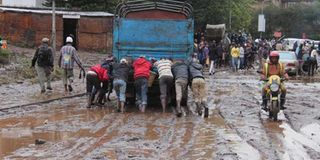How to drive safely this season, come rain come weather

Good Samaritans help push a vehicle that was left by the owner in South C after roads were flooded following a heavy downpour on May 12, 2015. Even with El Nino widely predicted, the principles of driving in the wet do not change at all. But the frequency, severity and duration of the rains will. PHOTO | FILE
What you need to know:
- Reduced traction — whatever your tyres or driving style are like, you have less grip than in the dry, so ease off, leave bigger margins, and use anticipation to avoid sudden acceleration, braking or cornering.
- Reduced visibility — even if your wipers and demister are in good order, make your surrounding observation more deliberate, more careful.
Even with El Nino widely predicted, the principles of driving in the wet do not change at all. But the frequency, severity and duration of the rains will.
And here’s another point to ponder: with our vehicle/driver population growing so rapidly, tens of thousands of your fellow road users will be steering their way through a rainy season for the first time.
That’s enough to ensure that, wherever you are driving, some of them will be splashing through or sliding off the learning curve right next to you. So add that to the hazard list in the coming month(s) — and hope they are quick to learn (and more experienced motorists don’t forget) the lessons of experience.
Reduced traction — whatever your tyres or driving style are like, you have less grip than in the dry, so ease off, leave bigger margins, and use anticipation to avoid sudden acceleration, braking or cornering.
Reduced visibility — even if your wipers and demister are in good order, make your surrounding observation more deliberate, more careful.
Double check (especially when you think you don’t need to!).
Tension — anyone who is not completely spaced out (which is hardly a safe condition) will be more anxious in wet conditions, so make a conscious effort to be relaxed and stay relaxed. And alert. No matter how crazy the traffic, or how big the jam, or how pressing your schedule is.
TORRENTIAL RAINS
Outsiders — extend especial consideration and sympathy and courtesy to them; realise they are more vulnerable and more uncomfortable and be helpful. Vehicle fitness — good standards of roadworthiness are important in all conditions, but they are even more crucial in the wet, particularly the condition of tyre treads, effective wipers, washers and demisters, brakes that bind evenly, lights (front and back) that are more prone to blowing bulbs or being obscured with mud, and the integrity of ignition systems so the engine is less likely to be splashed to a stall.
These are the keynotes whenever it rains, even briefly and moderately; indeed, tarmac roads can be most slippery in light rain after a dry spell. But El Nino, if it happens, does significantly increase the chances of aquaplaning because heavy rain will cover the road in a deeper film of water, cause bigger puddles and risk drainage ditches flooding into shallow rivers across the road.
Torrential rain, especially on already sodden ground, greatly increases the chances of floods — water that is several inches, and perhaps several feet, deep that could bring some cars or all traffic to a complete standstill. Here the big issue for newcomers is judgement; not being so cautious that all other traffic is disrupted, and not being so bold that real danger is caused.
There is a fine line between dithering and dying. Estimating the maximum navigable depth for your particular car — in low gear, at low speed and at high engine revs — is a skill to develop. But first and above all, because it can make a life and death difference, is whether the floodwater is still or flowing ... and how fast it is flowing.
The rational rule is “if in doubt ... don’t”. But, in parallel, getting it wrong in still water is at worst mechanically damaging. Getting it wrong in fast flowing water is deadly. Spot the difference.





